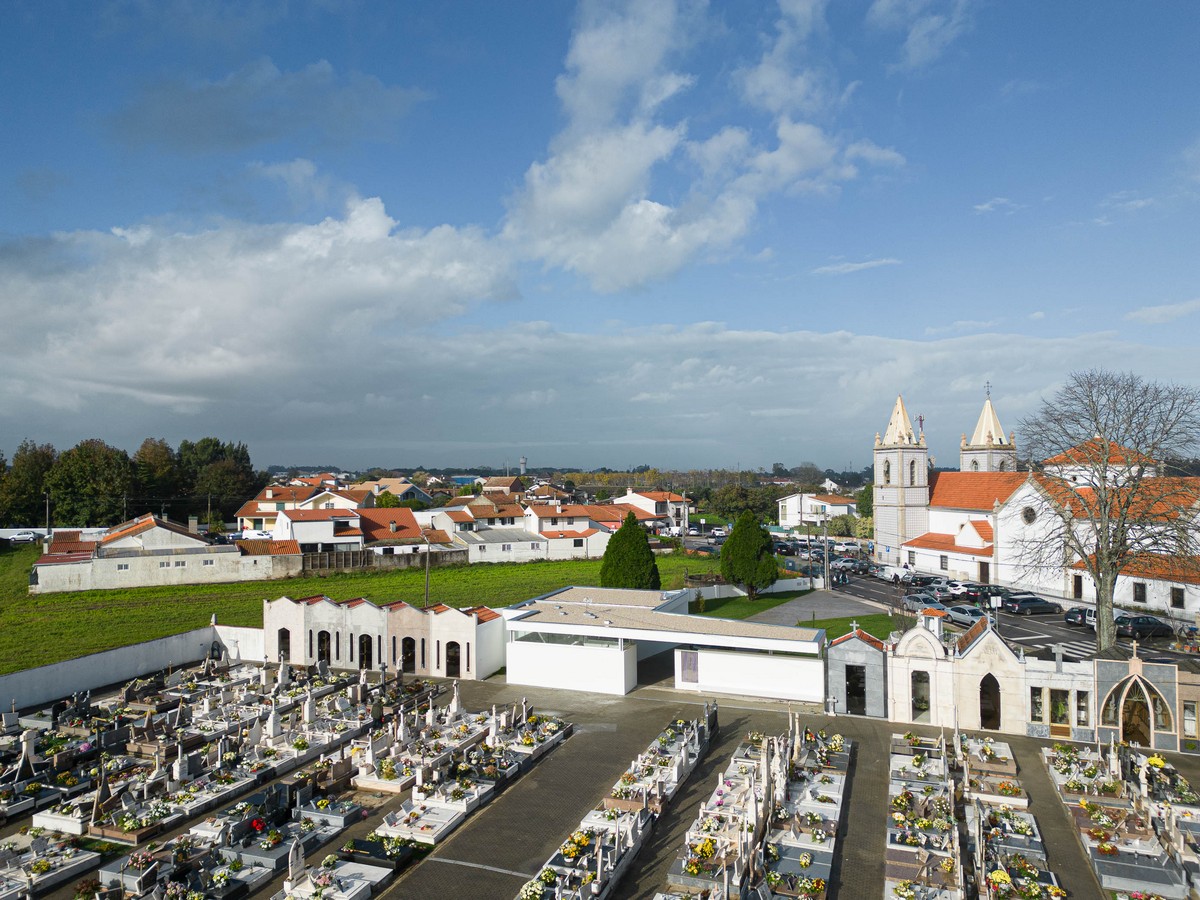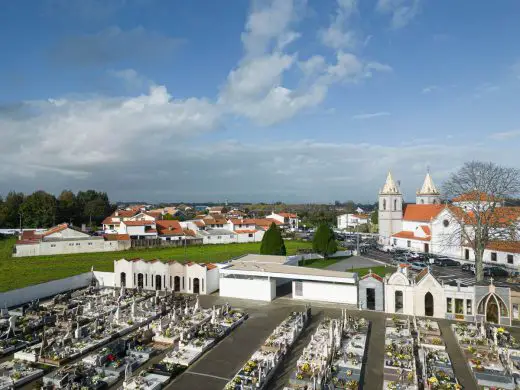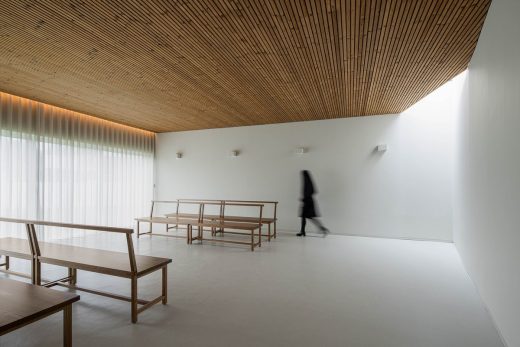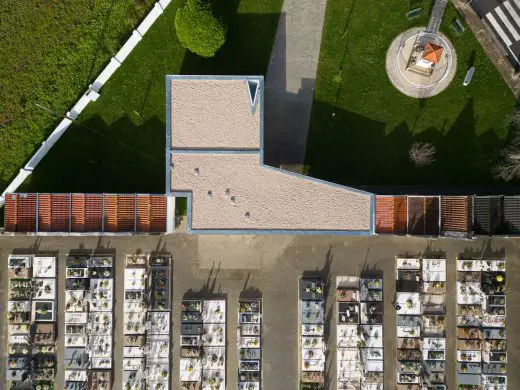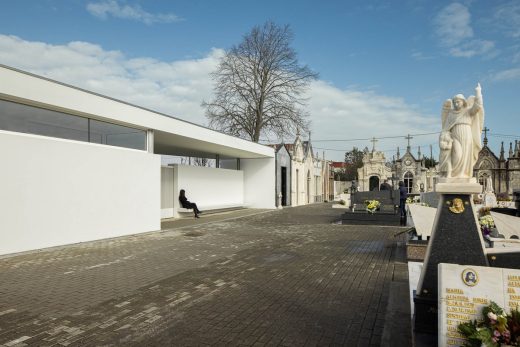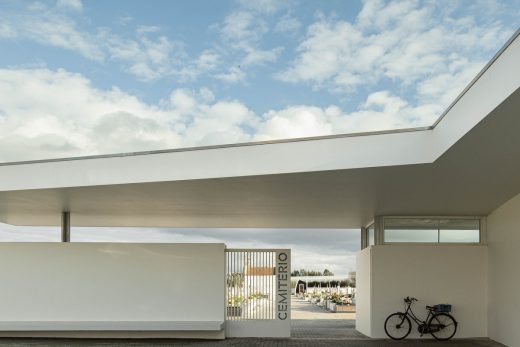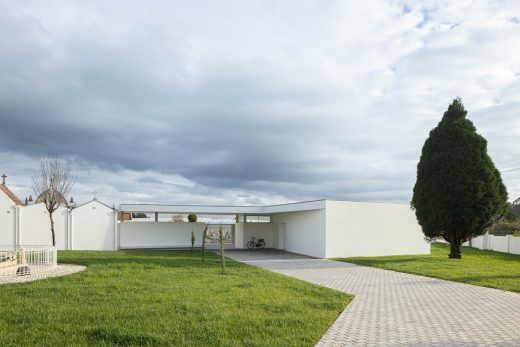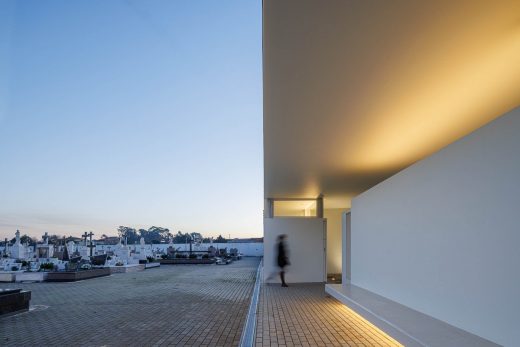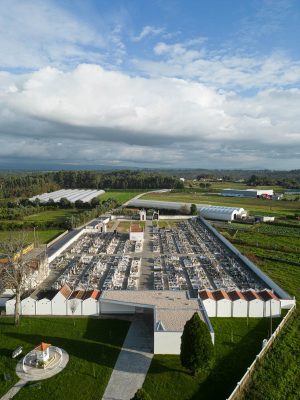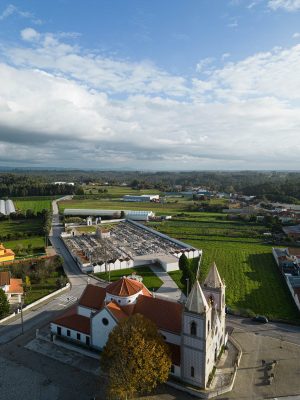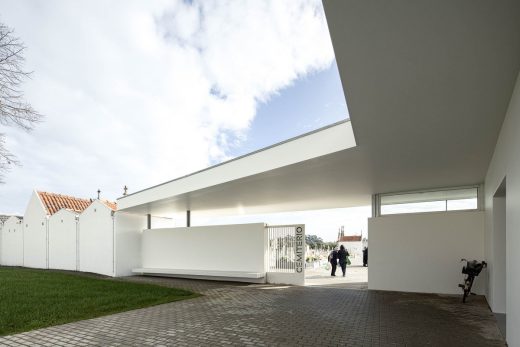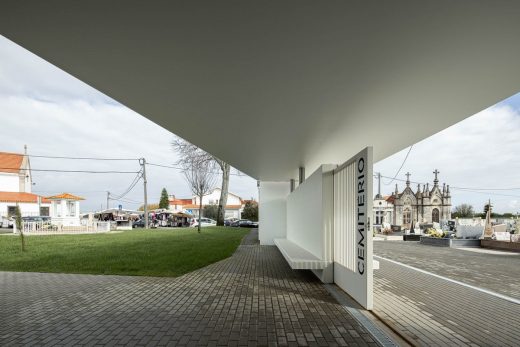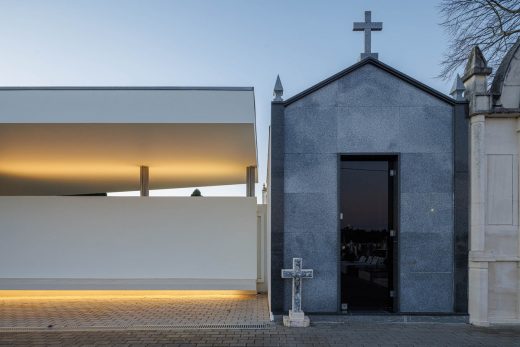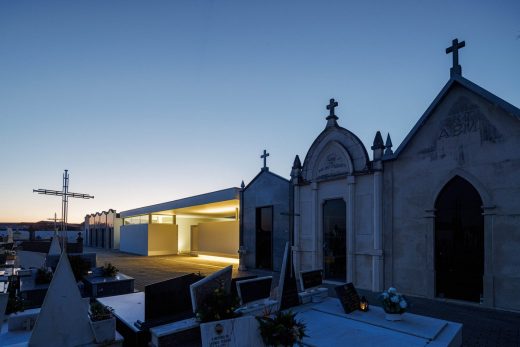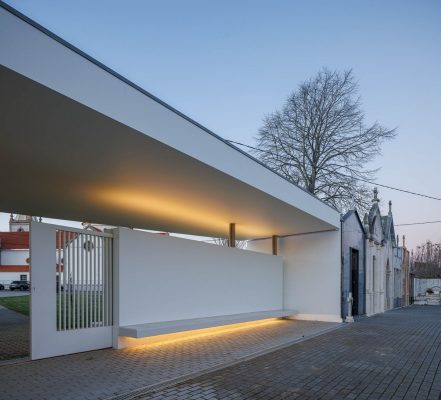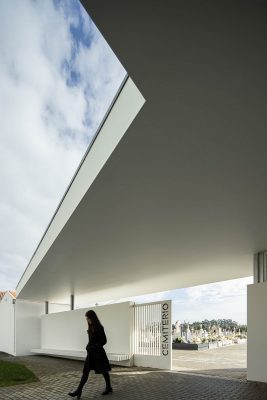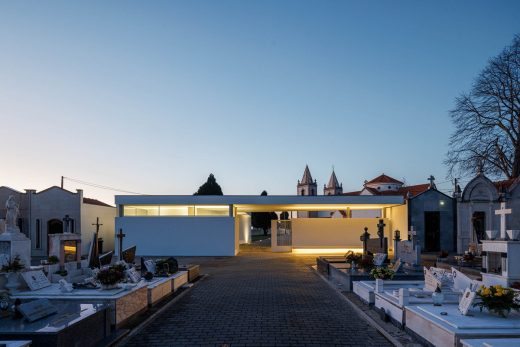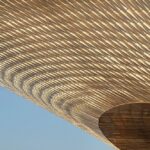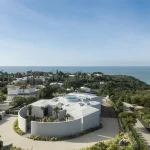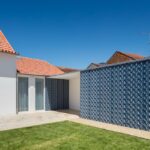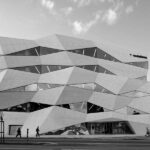Casa Mortuária de Oliveirinha Aveiro, Portuguese architecture, Portugal building photos
Casa Mortuária de Oliveirinha in Aveiro
26 July 2024
Architects: Sónia Lopes da Cruz – Arquitectura
Location: Oliveirinha, Aveiro, Portugal
Photos by Ivo Tavares Studio
Casa Mortuária de Oliveirinha, Portugal
Casa Mortuária de Oliveirinha
In addition to responding to the need for a wake space, the intervention is intended to provide an opportunity to harmonize and unify the surrounding area and access. The approach is not only to create an independent building with the necessary features to house the planned program, but also to create a silent piece of architecture capable of reorganizing and requalifying the existing space.
The intervention area is characterized by the disarticulation between spaces and pedestrian accesses, with disharmony between the materials and languages present there, resulting in a disqualified space. On observing the site, several constraints were identified which the proposal considers and seeks to resolve, and which can be summarized in the following points: disqualified entrance; physical pre-existence (boundary of the cemetery, monument/oratory to Our Lady, ancillary buildings (gatehouse, storage and sanitary facilities); disarticulation between the cemetery access and the parish churchyard; entrance front marked by the gables of the tombs; degradation of the public sanitary facilities; lack of technical support areas for the gravedigger; customs, traditions and experiences linked to and established by the community.
In order to respond both to the initial program proposed by the developer and to the specific needs of the site, it was decided to strategically place the mortuary next to the cemetery entrance. It is proposed that the building be placed next to the main entrance to the cemetery on the west side, so as to create a new element on the cemetery’s street front, drawing attention away from the poorly qualified back façades of the funeral chapels.
On the north side, the placement of the mortuary suggests a new alignment that tries to relate the funeral complex (cemetery) to the main churchyard of the parish church, suggesting to the user a common physical and visual relationship. On the south side, inside the cemetery, the layout respects and reinforces the alignment of the common front of the funeral chapels.
The built volume of the mortuary has a horizontal visor on its roof that stands out from the main volume, articulating and relating the implantation of the mortuary volume with the strong orthogonal alignments present in the internal organization of the cemetery. This flat roof and visor will constitute and qualify the main entrance to the cemetery, providing a covered space, shelter for rainy days and sunny days. On the east side, a fence wall will be built incorporating structural elements of the roof, as well as benches on both the internal and external sides of the cemetery. The proposal calls for a careful and sensitive intervention in relation to the cemetery’s physical and formal circumstances. In this way, the elements to be built will not physically contact the pre-existence, treating the void as an element of transition between volumes.
The materialization of the proposed construction is done intentionally using simple, sober and contemporary design and materials, assuming a minimal architectural language that is distinct from the other funeral constructions that make up the cemetery. It is intended to be a silent, unmarked and discreet intervention, which integrates positively with the building as a whole and does not stand out. The general exterior cladding of the building is a polished concrete grey plaster, close to the color of the sidewalk that makes up the entire complex, as if it were a common stain. The openings will have flat aluminum frames in a dark matt anthracite color. The gate will be made of anthracite-colored metalwork with vertical elements and, when open, will be recessed and hidden in the east wall.
The program is organized in a simple and pragmatic way. With independent access from the cemetery, the building will include a viewing room, a toilet and a storage room. The wake room is connected to the outside by a large opening facing west, taking advantage of the garden space as a backdrop for the coffin during the wake. In addition, and with access from inside the cemetery, there will be a storage room and a complete sanitary installation for the employee responsible for maintaining the cemetery.
Portuguese:
Casa Mortuária de Oliveirinha, Aveiro
A Intervenção, para além de responder à necessidade de um espaço de velório, pretende constituir uma oportunidade de harmonizar e unificar a sua área envolvente e acesso. A abordagem recai, não só na intenção de constituir um edifício independente com as valências necessárias para albergar o programa previsto, mas também na constituição de uma peça arquitetónica silenciosa capaz de reorganizar e requalificar o espaço existente.
A zona de intervenção, caracteriza-se pela desarticulação entre espaços e acessos pedonais, com desarmonia entre os materiais e linguagens ai presentes, resultando num espaço desqualificado. Na observação do local, identificam-se várias condicionantes que a proposta considera e procura resolver, e que se podem sintetizar nos seguintes pontos: entrada desqualificada; pré existências físicas (limite do cemitério, monumento/oratório a Nossa Senhora, construções anexas (portaria, arrumo e instalações sanitárias);desarticulação entre o acesso do cemitério e o adro da igreja paroquial; frente de entrada marcada pelas empenas dos jazigos; degradação das instalações sanitárias públicas; inexistência de zonas técnicas de apoio ao coveiro; costumes, tradições e vivências vinculadas e estabelecidas pela comunidade.
No sentido de responder tanto ao programa inicial proposto pelo dono de obra, como às necessidades específicas do lugar, opta-se por uma implantação estratégica da casa mortuária junto da entrada do cemitério. Propõe-se que a implantação da edificação seja feita junto da entrada principal do cemitério do lado poente, para que seja constituído um novo elemento na frente rua do cemitério, desviando a atenção das fachadas tardoz das capelas funerárias, pouco qualificadas. Do lado Norte, implantação da casa mortuária sugere um novo alinhamento que tenta relacionar o complexo funerário (cemitério) com o adro principal da Igreja matriz, sugerindo ao utilizador uma relação física e visual comum. Do lado Sul, interior do cemitério, a implantação respeita e reforça o alinhamento da frente comum das capelas funerárias.
O volume edificado da casa mortuária materializa, na sua cobertura, uma pala horizontal que se destaca do volume principal, articula e relaciona a implantação do volume da casa mortuária com os fortes alinhamentos ortogonais presentes na organização interna do cemitério. Esta cobertura plana e pala constituirá e qualificará a entrada principal do cemitério, promovendo um espaço coberto, abrigo para os dias chuvosos e para os dias soalheiros. Do lado Nascente, será constituída uma parede de vedação que incorpora elementos estruturais da cobertura, e bancos de apoio tanto no lado interno como externo do cemitério. A proposta propõem uma intervenção cuidada e sensível no que diz respeito à relação com a circunstância física e formal do cemitério. Desta forma, os elementos a constituir não contactarão fisicamente com a preexistência, tratando o vazio como um elemento de transição entre volumes.
A materialização da construção proposta é feita recorrendo intencionalmente a desenho e materiais simples, sóbrios e contemporâneos, assumindo uma linguagem arquitectónica minimal distinta das demais construções fúnebres que compõem o cemitério. É intencional uma intervenção silenciosa, desmarcada e discreta, que integre de uma forma positiva o conjunto edificado e não se destaque.
Opta-se como revestimento exterior geral da construção um barramento de reboco polido de cor cinza betão, próximo da cor do pavimento compõe todo o complexo, como se de uma mancha comum se tratasse. Os vãos serão com caixilharia chapa lisa de alumínio cor escura antracite mate. O portão será em serralharia cor antracite com elementos verticais e, quando aberto, ficará recolhido e oculto na parede nascente.
O programa é organizado de uma forma simples e pragmática. Dotado de acesso independente do cemitério, o edifício, integrará uma sala de velório, uma instalação sanitária, e um arrumo. A sala de velório relaciona-se com exterior a partir da abertura de um grande vão voltado a Poente aproveitando o espaço de jardim como pano de fundo para o enquadramento do caixão nos momentos de velório. Em complemento, e com acesso a partir do interior do cemitério, existirá um arrumo e uma instalação sanitária completa para o funcionário responsável pela manutenção do cemitério.
Casa Mortuária de Oliveirinha in Aveiro, Portugal – Building Information
Architecture Office: Sónia Lopes da Cruz – Arquitectura – https://soniacruz-arquitectura.com/WP/
Project name: Casa Mortuária de Oliveirinha
Main Architect: Sónia Cruz
Collaboration: Rui Vieira, Inês Lopes
E-mail: geral@soniacruz-arquitcetura.com
Facebook: https://www.facebook.com/soniacruz.arquitectura/
Instagram: https://www.instagram.com/soniacruz.arquitectura/
Location: Oliveirinha, Aveiro, Portugal
Year of conclusion: 2023
Total area: 220 sqm
Builder: HFN Construções SA
inspection: CMA
Engineering: R5 Engineers
Landscape: Sónia Cruz Arquitectura
Light Design: Sónia Cruz Arquitectura
Acoustic Design: R5 Engineers
Fluids Engineering : R5 Engineers
Thermal Engineering: R5 Engineers
Visual . Visual identity: Sónia Cruz Arquitectura
Illustrations: Sónia Cruz Arquitectura
Interior Design: Sónia Cruz Arquitectura
Architectural photographer: Ivo Tavares Studio
Facebook: www.facebook.com/ivotavaresstudio
Instagram: www.instagram.com/ivotavaresstudio
Casa Mortuária de Oliveirinha, Aveiro, Portugal images / information received 260724
Location: Oliveirinha, Aveiro, Portugal, southwest Europe
New Portuguese Architecture
Contemporary Portuguese Architecture
Portuguese Architectural Designs – chronological list
Lisbon Architecture Tours by e-architect
Portuguese Houses
Selection of interesting Residential Projects in Portugal:
Casa Salicos, Carvoeiro, Algarve
Architects: STUDIOARTE
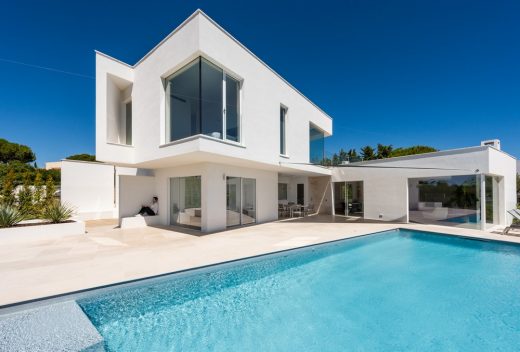
photo : Da Cruz Photo – Luís da Cruz
New House in Algarve
Houses in Calçada dos Mestres neighborhood, Campolide hill, Lisboa
Design: Orgânica architecture office
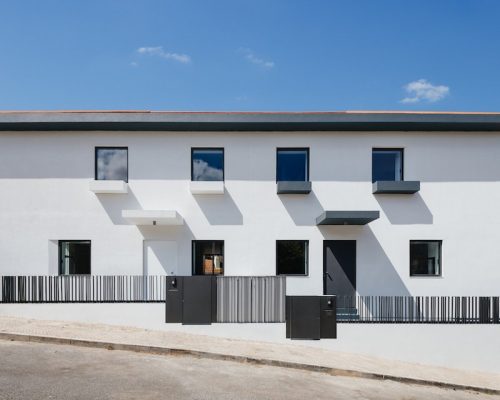
photograph : Do Mal o Menos
Houses in Calçada dos Mestres
Casa Moreira
Architects: César Machado Moreira architect
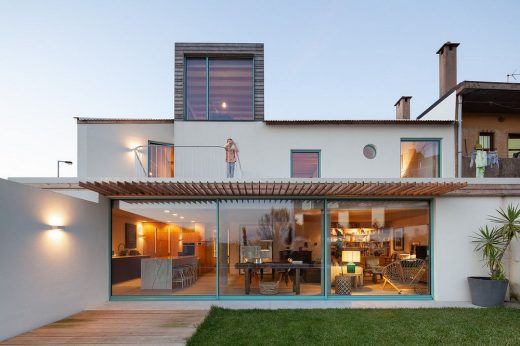
photograph : José Campos
New Home in Porto
Ring House
Design: Vasco Cabral + Sofia Saraiva
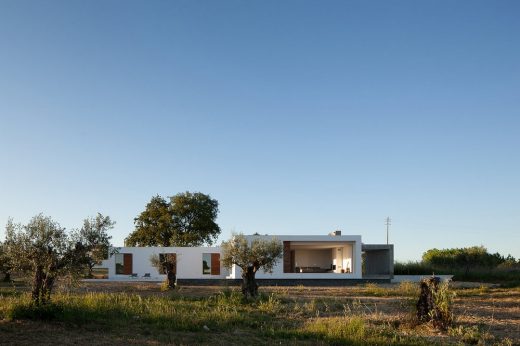
photograph : José Campos
New House in Santarém
Comments / photos for Casa Mortuária de Oliveirinha, Aveiro, Portugal property design by Sónia Lopes da Cruz – Arquitectura page welcome.

